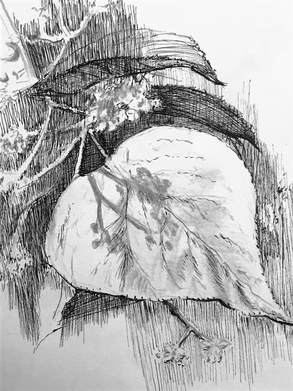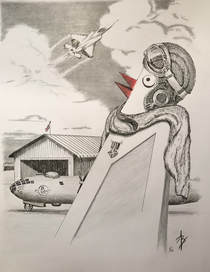 The change of seasons, between Winter and Spring, is marked with celebration for many cultures throughout the world. Bonds of tribal membership are strengthened and cared for through traditions of religious ceremony; often symbolic song, prayer, feasting, dance and colorful gifts, repeated year after year. The celebration of Easter, for Christians, is significant, none more so than for the tribe known as the Moravian Church; aka Unitas Fratrum, Evangelische Brudergemeente, IGLESIA MORAVA, Jednota Braterska, Bra’lu drandze, Brodremenigheden, and more. Now, miles and years from the church of my youth and childhood, the memory of our traditional celebration of Easter at the restored 1770s "Moravian mission to the Delaware Indians" in the Ohio Territory lingers in my mind and imagination. Our family would rise in the dark, bundle-up in winter clothes and drive to Schoenbrunn Village. Armed with flashlights, we'd gather in front of a huge log-cabin church, it's door open slightly to the allow the exit of heat and smell of wood fire, mingled with coffee and hot chocolate prepared to warm choirs, brass instruments, and local pastors who had gathered long before our arrival. At a given hour, choirs and pastors took their places to announce "The Lord is Risen!" to which all would respond in unison "He is risen indeed!" followed by glorious music as the sky began to glow and birds awoke. The ceremony was short, interrupted with a walk to "God's Acre" (cemetery), accompanied along the path with choirs of brass and voice, interspersed so that their music called and answered each other during our walk. At God's Acre, standing among ancient gravestones, more music and prayers brought joyful conclusion. I could not stand with head bowed however. Instead I'd watch this magnificent panorama overhead, as golden rays of sun unfold behind distant hills, then creep down from the tops of trees around us to the cabin roofs, to finally land on the path for our return home (where hot chocolate is promised). Sunrise and Son rise are synonymous.
0 Comments
 In a recent trip to Europe, I was introduced to the Linden Tree: A handsome hardwood which slowly grows into a crown of saw-toothed heart shaped leaves, at maturity as much as 80 to 140 feet tall. The trees that I saw have an interesting way of surviving. If a limb is broken or trunk suffers major damage, it doesn't die but new growth emerges from the wound. From the old growth nutrition is still offered to the new growth. This feature results in deep scars and a misshapened appearance of trunk and limbs, but an amazingly hearty and resilient creation. The Linden also has an interesting blossom. From a stem attached to the underside of the heart-shaped leaf grows a burst of white pedals. This flower seemingly remains sheltered by the leaf until the moment in growth is right to peek out, then reach out for life giving beams of sun. Reflecting upon this during Lent, this plant seems to offer a metaphor, a message as though the hand of God protects the emerging bloom until time to blossom. And continues to provide abundant nutrition and options throughout hardships of life. In my gallery I add, from my sketchbook, my rendering of the Linden Tree leaf and blossom with wishes for a blessed Easter and Passover and promise of the season for a life fullfilled.  Like so many little villages scattered along the East Coast, history seeps from the image of sleepy streets, safe harbors and fishing piers. Friends at Southport, N.C., with warm sun and green beer, welcomed our St Patrick's day visit this weekend. Discovered in 1500s where Cape Fear River empties into the Atlantic, a British fort was built in the 1700s to defend nearby settlements from Spanish privateers and pirates. Smithville, a fishing village across the river from Fort Johnston, provided the fort supplies and services. It's name was changed in 1887 to Southport to identify itself as a port for commercial ship traffic. Wilmington, further up-river, ultimately became the preferred deep water port. So Southport retains it's village charm; moss sways from the outstretched arms of Live Oaks lining the streets to frame cozy victorian cottages, each with a hushed story to tell from it's front porch. This "port" on the Intracoastal Waterway remains a commercial center for fish and shrimp as well as a haven for pilot boats, ferry and yachts, and now provides a backdrop for music and nightlife. I'm adding to my gallery a few sketches made from previous visits. This visit prompted ideas for more scenes of Southport, to be added later. I'm opened to more ideas from my "Tar Heel friends". Spring has arrived. Stay tuned.  As the N.E. continues to get slammed with winter, the South simply shivers. So I'm adding some sketches of flowers and plants to my gallery today. Some of these are pen only, some with graphite and some a mixture of media. A lot of experimentation going on due to the difficulty of capturing the soft blend of foliage with what may be considered unforgiving harshness of ink. Look carefully at these and you'll see the problem for the artist. The image attached to this blog is of a Iris refugee, immigrated to our garden in Georgia from Ohio, and discovered after a spring shower, raindrops still shimmering on the blossoms.  What's that I smell in the air? Could it be Springtime? Following a strange winter, some plants are blossoming eagerly while others are understandably cautious. Daffodils long gone, Usually mid March is a time for more optimism Redbuds are now out, followed by Cherry blossoms. Soon Dogwoods will fill the woods and roadsides! HoHum... Just another spectacular Spring in Georgia!  In the 50's, every small town large enough to support a movie theater had kids who also found some of their values formed by what they saw there. Riding my bike to town, 16 cents used to get me into a matinee performance of Tom Mix or Superman, of course being viewed from the front seats of the theater. As I aged, I found greater appeal to the rear seats, at night ... with my date. Whether Bexley Theater in Dover, or the Strand Theater in Marietta, a similar nostalgic refrain is recited from those of our generation. So, while the Bexley crumbles, the Strand is revived by generous contributions from Earl and Rachel Smith and others dedicated to not just keep an attractive building on our Square, but to also keep the memory alive and the history vibrant. Here, even the Big Chicken gets all decked for an evening at "the theater".  The F-22 was a major Lockheed contract concluded a few years ago. Chickens are not necessarily known for their proficiency in flying, nor bravery. So, no one knows how the Big Chicken earned the Distinguished Flying Cross medal. Could it be this was simply a photo-op with the F-22 being flight tested after coming off the assembly line? In the 1940's, General Lucius Clay and his childhood playmates inexorably linked Marietta and Cobb County to the federal government's war effort. Following the purchase of farm-land upon which to build the Bell Bomber plant and Rickenbacker Airfield, Cobb farmers and Marietta villagers became skilled craftsmen and women who produced over 600 B-29 bombers during the World War II. This ultimately proved the "South" had a role to play in the post-war industrial age.
In the 1950s, Lockheed-Martin purchased the remains of the Bell Bomber plant. Rickenbacker Field became Dobbins Air Force Base. In time, producing reliable cargo carriers became a priority for the military and Lockheed began manufacturing the C-130. Named "Hercules", this aircraft remains unique for it's load capacity, it's design to land and takeoff in challenging conditions, and the reliability and efficiencies of it's turbo-thrust engines. The C-130, and those who build it, now share a proud history for its contribution throughout the world. Here, the Big Chicken stands at attention, the B-29 in the background, as the "Hercules" passes overhead. |
AuthorBill Needs Archives
January 2024
Categories |


 RSS Feed
RSS Feed